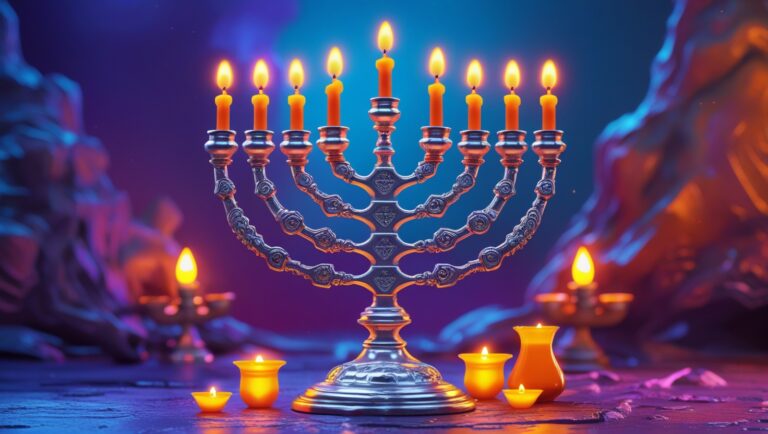The Mitzvot of Tefilin, one for the head and one for the arm, are 2 of the most cherished among Jewish men.
Also known as phylacteries, they are essentially small black leather boxes containing Torah scrolls worn during weekday morning prayers which are attached by leather straps.
For thousands of years, this mitzvah has been a cornerstone of Jewish practice, symbolizing the binding of the heart and mind in devotion to Hashem. Even non-religious men make an effort to at least put Tefilin and say the Shema so as to fulfil their Mitzvot. But, beyond the halachic (Jewish legal) obligations, Tefilin embody deep layers of Kabbalistic secrets.
Most men however use only the Rashi Tefilin, which bring in the Mokhin of Binah. Others also add the Rabbenu Tam Tefilin, which bring in the Mokhin of Chokhmah. Some put both together (if they are small enough to fit the head), and these two Tefilin are from the general system of Yisrael Sabah and Tevunah of the Partzuf of Mitzvot. A lesser known Tefilin called the Shimusha Rabbah is used by few men during Mincha and bring also the Mokhin of Keter. In all three cases, we are essentially bringing back the Reshimo of the Mokhin of yesterday’s Partzuf which left by nightfall.
It is a known custom from the Ben Ish Chai of learning with the Tefilin after Shacharit. R’ Yehuda Fetaya adds that this helps a person bring in a portion of his Ruach, which is a testament of their power to rectify a person.
1. The Commandment of Tefilin: Origins and Halachic Overview
Let’s start with the basics: The Mitzvah of Tefilin finds its origins in the Torah, specifically in four key passages that are inscribed within them: Shemot 13:1-10, Shemot 13:11-16, Devarim 6:4-9 (the Shema), and Devarim 11:13-21 (the Vehaya). These texts highlight the centrality of remembrance and dedication to Hashem, encapsulating the call to “bind these words as a sign upon your hand and as frontlets between your eyes” (Devarim 6:8).
Essential Halachic Details:
- When and How They Are Worn: Tefilin are worn by Jewish men, typically from the age of Bar Mitzvah (13) but most start even earlier as Chinuch (education) for the Mitzvah. They are donned during weekday morning prayers, with exceptions on Shabbat and major Jewish holidays due to the inherent sanctity of those days which are also called “Ot” (a sign) like the Tefilin. Since we have one sign of the day that we bind ourselves to Hashem, we don’t need another sign on the head and arm.
- Physical Placement: The Tefilin Shel Yad (arm Tefilin) is bound to the upper arm, facing the heart, while the Tefilin Shel Rosh (head Tefilin) is placed above the forehead, aligning with the brain. This arrangement symbolizes aligning the emotions (heart) and intellect (mind) with divine service.
- Material Requirements: According to Talmudic sources (Menachot 42b) and Shulchan Aruch (Orach Chayim 32), Tefilin must be made from the skin of kosher animals, and the writing of the scrolls must be done by a skilled sofer (scribe) adhering to strict guidelines of Kedusha.
Like all Halachot, these of the Tefilin are not just technical stipulations but are rooted in the wisdom of Kabbalah.
2. Components of Tefilin: Construction and Symbolism
The construction of Tefilin is intricate, embodying layers of symbolism within every element:
- Tefilin Shel Yad and Shel Rosh: The arm Tefilin (Shel Yad) is wrapped around the arm seven times, facing the heart, symbolizing dedication of strength and emotion to God and also the 7 Heichalot (chambers) which are Livnat HaSapir (Sapphire stones – Malkhut and Yesod), Etzem Hashamayim (Essence of Heaven – Hod), Noga (Brilliance – Netzach), Ratzon (Desire – Tiferet) Zechut (Merit – Gevurah) and Ahava (Love – Chessed). The head Tefilin (Shel Rosh) has four compartments containing separate scrolls, each with one of the Torah portions, symbolizing not only the compartmentalization of thoughts into focused devotion but also the 4 Mokhin (Chokhmah, Binah, Chassadim of Da’at and Gevurot of Da’at). These Mokhin are separated when they come down to the head but become joined in the arm when we only have 1 compartment.
- The Scrolls Inside: The handwritten scrolls are perhaps the most sacred part of Tefilin, containing the four Torah passages that outline the essence of Jewish faith and practice. Mishneh Torah (Tefilin 1:1) and Shulchan Aruch (Orach Chayim 32:19) provide in-depth descriptions of the precise calligraphy and layout necessary for these passages.
Hopefully, we will deal with the caligraphy of the divine name YHVH in another post.
Symbolic Representation:
Tefilin’s design reflects the integration of various aspects of human faculties:
- Mind, Heart, and Action: Wearing Tefilin symbolizes the commitment to align thoughts (mind), emotions (heart), and deeds (action) with God’s will. This triadic connection mirrors the core Kabbalistic principle of balancing the three pillars: Chochmah (wisdom), Binah (understanding), and Da’at (knowledge).
- Unity of Divine Connection: The division between the Shel Rosh’s compartments and the singular nature of the Shel Yad box brings forth the idea of the unity of God and the multifaceted nature of divine light as it manifests in the world. The Zohar (Volume 2, 43b) explains how Tefilin serve as a bridge connecting the spiritual and physical realms, infusing the wearer with a subtle but powerful divine influence.
3. Kabbalistic Meaning of Tefilin, the Knots and Straps
As we saw, Tefilin are much more than ritual “objects” rather, they are considered channels through which divine energy flows into the physical world. According to the Zohar (Volume 3, 250b), the act of donning Tefilin aligns the wearer with the upper spiritual worlds, creating a direct link between the individual and higher realms of consciousness. We men are essentially channeling this light down here.
This act embodies the principle of “binding” oneself to God, an idea mirrored in the Hebrew word Tefllin, which comes from the root tefillah (prayer) and pelilah (judgment), emphasizing introspection and spiritual alignment. As an aside: This spiritual concept has been used in a corrupt way by sorcerers and priests of other traditions that seek to imitate and bring alignment with demons.
In the Zohar (Volume 2, 44a) we learn about the protective qualities of Tefilin, noting that when one wears them with proper Kavanah (intention), a spiritual light surrounds the individual, shielding them from negative influences. This light is described as being linked to the divine attribute of Keter (Crown), which represents the highest connection to the divine will. Indeed a man who has the capacity to wear Tefilin but doesn’t while saying the Shema Yisrael is considered a liar because he’s lacking this component of unity.
The knots and straps of Tefilin carry profound symbolism within Kabbalistic teachings. According to the Arizal, the knot of the Tefilin Shel Yad forms the shape of the Hebrew letter Yud, while the knot of the Tefilin Shel Rosh forms the shape of the letter Dalet. Together with the strap that forms a Shin on the arm, these three letters spell out one of the divine names: Shaddai (שדי), which is associated with divine protection and power.
The way the straps are wrapped around the arm and hand is connected to the divine name Havayah (the Tetragrammaton), symbolizing the binding of human actions to the divine will. According to Rabbi Chaim Vital in Sha’ar HaKavanot, the seven wraps on the arm are also associated with the seven lower Sefirot (Chesed through Malchut), representing how divine attributes manifest in the human body and actions.
5. Meditative Practices and Kavanot While Wearing Tefilin
Wearing Tefilin is not just a physical act; it is an invitation to profound spiritual meditation. Many Tannaim would not go outside without them as they were powerful tools to command energy. The Arizal emphasized that focusing on Kavanot (spiritual intentions) while donning Tefilin can amplify their mystical effect, transforming the wearer’s state of consciousness. Indeed many know of the prohibition of “taking one’s attention away from them” while wearing them.
Here we have a few simple Kabbalistic Meditations:
- Contemplating Divine Light: One common practice is to visualize divine light descending from the infinite Ein Sof (the boundless source of divine energy) into the Tefilin and spreading throughout the body. This meditation is rooted in Sefer HaBahir (Verse 53), which explains how divine light interacts with human consciousness.
- Focus on Divine Names: Meditators are advised to think of specific divine names when binding the straps, such as Shaddai for protection or Havayah for divine unity. Rabbi Yosef Gikatilla’s Sha’arei Orah (Gates of Light) suggests that this practice helps attune the soul to the Sefirot and divine emanations.
- Integration of Mind and Heart: Meditating on the connection between the Tefilin Shel Yad (near the heart) and the Tefilin Shel Rosh (on the head) helps the wearer align their intellect with emotions, ensuring that both work harmoniously in divine service. This mirrors the idea found in Tanya (Chapter 41), where Rabbi Shneur Zalman of Liadi discusses the concept of using Tefilin as a tool for achieving a state of bitul (self-nullification) before God.
Advanced Kavanot for Tefilin
This Yichud below is meant to be intended before making the brakha and is meant to also rectify for all the times a man failed to put on tefilin. Keep in mind that even if one hasn’t ever missed a day in his life, it could be his previous reincarnations did, so it’s always a great idea to use it (besides the effect of the unification itself).
Once the brakha is made, we should also meditate on the divine names that spell out the word Tefilin as below:
Finally, the straps, which represent Netzach and Hod, have the Gematria of 371, which is 370 + the Kollel for the word and is related to the light of Arikh Anpin that is brought down below to unify the Partzufim of Zeir Anpin and Nukvah of Atzilut through the Ruach D’Chayey.
In summary, the Mitzvot of Tefilin contain many awesome secrets and so far we’ve barely scratched the surface. I do hope that men will come to a better appreciation of the Mitzvot of Tefilin though this article.
Let me know your thoughts in the comments below!







